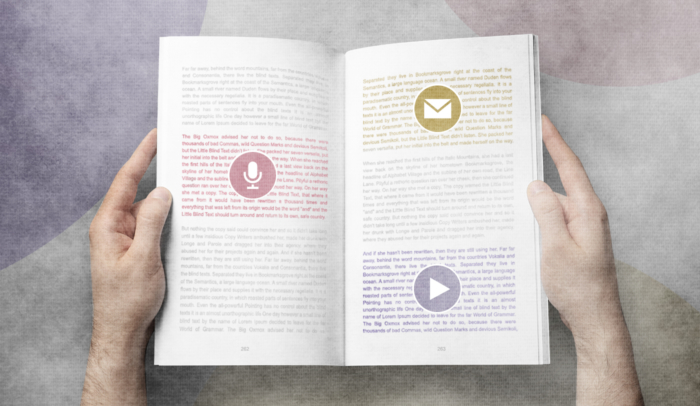One of the hardest things about content marketing is coming up with new ideas, week after week, month after month.
That is, unless you wrote a book.
If you’re a self-published author with a non-fiction book, you have a whole world of content at your fingertips.
That doesn’t mean you can simply lift entire sections from your book and paste them into your blog. However, your book can be an endless source of ideas.
And you can repurpose every one of those ideas into different formats.
Turn your blog post into a podcast. Turn your podcast into social media video clips. Great content is great content in any form.
When you use your book to work smarter, not harder, every piece of content you produce can spin out at least 3 or 4 other forms.
This post is a complete guide to repurposing your content, with 13 great ways to keep your book’s content going … and going … and going …

13 Brilliant Ways of Repurposing Content
1. From Book to Blog Posts
The trick to working smarter, not harder, is knowing where to put the work in. What you don’t want to do is lift pieces of your book and paste them into a blog post.
Why not? Because it isn’t adding any extra value.
The idea of content marketing for an Author is two-fold:
- Get people who haven’t bought your book to want it
- Get people who read your book to want MORE
More what? More you. More of your:
- ideas
- consulting services
- courses
- media appearances
- etc.
So how do you make that happen? By providing value over and over in the form of content inspired by your book (but not literally from your book).
Here are some examples:
- new case studies based on the ideas in your book
- content you had to cut from your book
- success stories about people using your book
- news stories that illustrate the principles in your book
Does that mean you need a complete website for your Author blog? Not at all. If you want to write posts without maintaining a blog, publish your posts on LinkedIn, Medium, Facebook, or even all 3 (depending on your target audience).
2. From Blog Posts to Book
Having a successful blog is a great place to start when it comes to writing a book. It might not be as simple as printing out 20 blog posts, pasting a cover on it, and calling it a day—but you’re still way ahead of the game.
Why? Because the toughest thing about writing a book is getting in the habit of churning out words consistently, and you’ve already done that.
Plus, Scribe has a system for turning your blog into a book that makes it relatively straightforward.
3. From Book to Video
Videos come in all shapes and sizes—from clips that last only seconds to YouTube podcasts that can go for hours.
How much you want to do is completely up to you. It comes down to:
- your specific goals for your book
- where you want to put your time
The easiest way to convert your book into a series of videos (while adding new value) is to record yourself talking about things like this:
- Did something happen when you were a kid that set you on the path to writing your book?
- Are there specific people you wrote the book to help?
- What made you want to help in this way?
- Are there people your book has already helped?
- Is there something happening in the news right now that’s relevant to your book?
Any of these are great topics for short clips. And if you’re planning on turning them into Facebook or Instagram stories, they don’t even need to look like they were filmed in a studio.
Just make sure you look presentable, choose a pleasant background, and hit record.
That said, if your goal for your book is to attract media opportunities and build a reputation as a highly sought-after professional, you’ll need to invest in a professional videographer and editor.
Either way, you can use your book to generate great content.
4. From Video to Written Posts
If you made a series of videos first and you find yourself in need of written content, turning your videos into blog posts is pretty straightforward.
As always, it’s not as simple as writing down everything your video says and publishing that as a post. But the content is there. You just have to put it in a form that works well for a reading audience.
You can do that in 3 easy steps:
- Get a transcript of the video’s audio file. For short videos, YouTube’s free transcription is a great place to start. For longer videos, I recommend Temi if the recording is clear or Rev if it isn’t.
- Scan the transcript for content and write a brief outline.
- Use the ideas in the transcript to flesh out your post.
It’s easiest to turn short transcripts into short posts. But if you have a long transcript, you can use that one content source to create a whole series of posts.
5. From Written Posts to Video or Podcasts
If you have a series of blog posts already written and you want to start a video or podcast series, you can turn that old content into new content by changing formats.
For example, you can turn old blog posts into new interviews. Use your blog content as a base for your talking points. Then:
- invite experts to discuss those talking points with you
- or offer to be a guest on other people’s podcast episodes or youtube videos
Whether you’re applying to be a guest on an influencer’s podcast or inviting an influential expert to join you on yours, you can use the original post’s success as a selling point.
Influencers love popular content—as long as you can find a way to breathe new life into it with a new angle. This can include:
- current events that shed new light on your existing content
- evergreen content with a different angle for a new audience
- popular posts that confirm the influencer’s own messaging
If you offer to backlink your popular blog to the new interview (sending organic traffic from the original content to the new podcast or video), influencers will be even happier to take advantage of the digital marketing boost.
6. From Posts to Speaking Gigs
Similarly, both old and new posts can be repurposed into anything from Powerpoint slide decks to long-form speaking gigs.
Use them for:
- online courses and tutorials
- TEDx talks
- corporate training sessions
- coaching sessions
- any other kind of presentation you need
Depending on the circumstances, you can offer these for free or charge for them.
Keep in mind that a great content marketing strategy often converts free content into paying customers through sales funnels. You can offer free content through a form that asks for an email address, then add that address to your newsletter.
The more value you provide, the more people will want to connect with you, and the more opportunities you’ll get from that high-quality content.
7. From Podcasts to Articles (and vice versa)
Longer podcasts with more substance are often better suited to articles than blog posts. These types of content can be self-published on LinkedIn or offered to digital publications.
If you want to publish an original article in a digital magazine, never hide the fact that it’s based on an underlying piece of content. In fact, if you’ve done your job well, that’s a selling point.
Repurposing content isn’t about duplicate content. It’s about content creation.

Smart marketers reuse ideas to create something new.
Each new post or article is a genuinely new piece of material, based on something that’s already proven to be a popular topic.
Influencers want guest posts and interviews that will draw a crowd. So don’t hide your book, podcast, or blogging success. Capitalize on it.
8. From Written Content to Graphics
One of the easiest ways to turn written content into graphics is to create images out of short quotes—from your book or from any other written content you have.
Quote graphics are great for quick, eye-catching posts on social media that can spark a conversation.
9. From Anything to Infographics
You can turn just about anything into an infographic to add cool visual content to blogs, white papers, slideshares, email series, and so-on.
They’re also great for guest posting, especially if you’re willing to offer the infographic exclusively as part of your guest post.
One of the easiest ways to get content for an infographic is from surveys, which is another way for bloggers to generate new content based on older pieces of content.
Survey Monkey is an extremely easy way to run surveys. So if you have a popular post on your own blog, think about follow up questions that could generate content for a new blog post—maybe even a guest post—based on the popular one you already have.
Be sure to link from the popular existing post to the new one and back again to improve the search engine (SEO) rank of both posts.
10. From Graphics to Written Content
A picture is worth a thousand words. Literally.
Did you create graphics for your book? One of the best things about self-publishing is that you keep the rights to publish your book’s content in different forms. So you can post that graphic on your blog (or LinkedIn, or other social media) and write about it.
Not sure what to say? Try one of these:
- Why did you create that particular image or choose it for your book?
- How did you create it, or where did it come from?
- What does it illustrate, and why is it important?
- Does it illustrate a fact or statistic? When did you first learn about that fact or statistic, and how does it relate to your life?
11. From Anything to Social Media
This has to be the easiest one of all. You should always post short snippets about your other content and link to that content on social media.
It’s free advertising! Here are some ideas to get you started:
- Post a graphic from your blog with a short hook and link to the post
- Promote your new Youtube video
- Pose a question about your new infographic
- Link to the influencer you’re guest posting with and tag them
The options are literally endless.
If you don’t have a library of ready-made graphics and you want to spruce up your social media posts, check out the templates in Canva.
12. From Anything to Webinars (and Vice Versa)
Anything you can turn into a presentation or speaking gig, you can also turn into a webinar.
That said, do NOT republish something else by reading it on camera and then expect people to pay for it. I’ve said it before, and I’ll say it again:
Always add value.
That’s the content marketer’s mantra.
If your goal is to create and publish webinars for a living, consider offering at least one free mini-webinar to get people hooked. Then, sell the rest.
Just make sure they’re professional and that they add value.
If you wrote your book to sell something else, free webinars can be a great way to keep adding value until the people you’re helping are ready to take the next step.
13. From Anything to Your Newsletter
Finally, your email list is a brilliant opportunity for free advertising.
It’s even better than your social media following because, on any given day, only a small percentage of your followers will see your social media feed.
But your newsletter gets emailed directly to your best connections: the people who actively signed up for your content by giving you their email.
That’s incredibly powerful.
For most Authors, the best way to use your newsletter is to re-engage your readers by letting them know what you’ve posted this week (or this month) around the web.
It should highlight your best content with short hooks and excerpts that link to your blog posts, videos, podcasts, articles, webinars, etc.
If you’re creating long-form content like 30-minute podcasts or 3,000-word articles, consider creating bite-sized summaries of the key takeaways for your newsletter—like a digest.
Then, advertise that as a reason to sign up for your newsletter!
5 Great Examples: Repurpose Content Like a Pro
Want to see it in action? Here are 5 Authors who are creating and repurposing fantastic content for maximum results.
1. Garret Gunderson
Author Garret Gunderson has a well-known Youtube channel with a vast library of video content. For his Forbes page, he repurposed a lot of that content as written articles.
It’s a perfect example of offering value in different formats while remaining true to your core messaging and Author brand.
2. Will Leach
Will Leach, Author of Marketing to Mindstates, wrote a series of blog posts on using Game of Thrones to understand mindstate marketing.
Written in the Game of Thrones heyday, the series took off. It was shared widely on LinkedIn and picked up great SEO rankings. Not long after that, Merck approached him about doing a keynote address on this idea during one of their offsites.
He used the post series as a base and built it into a 60-minute presentation.
3. Kris Holmes
Kris Holmes is an executive recruiter and author of Ignite Your Career. Using her book as a base, she writes fantastic, highly skimmable LinkedIn posts like this one. They get a lot of attention in a very short space, no graphics needed.
4. Dr. Nashater Deu Solheim
Dr. Nashater Deu Solheim helps business leaders create healthy organizational cultures through applied psychology. Based on the messaging in her book, The Leadership Pin Code, her snappy posts on leadership keep her front-of-mind over and over, with minimal effort.
5. Marcus Whitney
Marcus Whitney, Author of Create and Orchestrate, leverages the entrepreneurial messages from his book—and his life—for podcast videos that he shares on LinkedIn. It’s a perfect example of creating fantastic content and cross-posting it on different platforms to expand your reach (with minimal extra effort).


